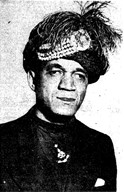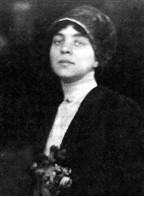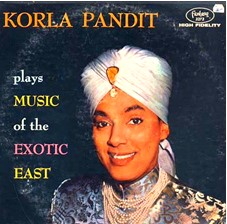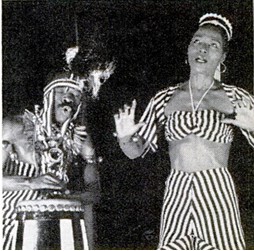Colourism, Passing, and the Bizarre Circus of Black Racial Imposters in 1950s America: Part Two
“Oh, what a tangled web we weave…when first we practise to deceive.”—Walter Scott, Marmion
The Double Crossers and Situational Passers
There are plenty of sober writings on the topic of passing and there are some reports that border on the absurd. One subset of passers deserve to be called double-crossers, for after living amongst those racialised as white, they were forced to revert to their previous identity as Black.
One of the earliest instances of someone of mixed Black heritage masquerading as another race or ethnicity, occurred in the 1820s. Highly regarded magician and ventriloquist Richard Potter, the son of a white tax collector and a Black servant, ventured outside of his Boston home where people knew his background. Away from New England, he encouraged the perception that he was “a Hindu” by dressing in costumes; advertised himself as “West Indian”; and while on tour in the South where slaves were concentrated, he pulled off his biggest stunt ever. . . . passing as white.
On returning home to Boston he quietly resumed being Black.
Two opposing points of view have been a voiced about Richard T. Greener (above right), the first African-American to graduate from Harvard University, concerning his interaction with a group of white Americans. From 1898 to 1905, he was a U.S. consular officer in Vladivostok, Russia. Why didn’t he present himself as Black when he socialised with them? Was he deliberately passing for white or was it that he just “didn’t see the point” in admitting his heritage?
Undoubtedly his daughter, Belle Marian Greener (left), weighed the apparent disadvantages of being black against the supposed benefits of being white. She thus morphed into the urbane Portuguese lady, Belle da Costa Greene, personal librarian and briefly mistress of multi-millionaire financier, J. P. Morgan. Unsurprisingly, she destroyed sensitive documents pertaining to her life prior to her death in 1950.
By the opening decade of the 20th century, olive-skinned Spanish-speaking Texas ex-slave, William Henry Ellis was a man of considerable wealth who, years earlier, had a well-earned reputation for working to defend and uplift fellow Black citizens. Few could recall that when he was becoming a proficient commodities trader in San Antonio, he had reinvented himself as Cuban/Mexican and had renamed himself Guillermo Enrique Eliseo. The advantage in being “Mexican” was that, as opposed to being black, this purposeful lie facilitated business transactions and social relations with both the white population and Mexicans. When he was exposed as being neither Mexican nor Hispanic, he fled to New York where he was identified as “Coloured” in telephone books. Ellis, his white wife (whom he falsely claimed had ties to British nobility), and children settled permanently in Mexico. There, he had once fraternised with leading politicians and businessmen and had owned the nation’s largest furniture store. He died in Mexico City in 1923.
For 43 years Wall Street attorney, Theophilus McKee passed for white. When he learned that his father, Black Civil War veteran Col. John McKee, had willed his sizeable fortune to care for orphans, Theophilus and his children challenged the will in court. In 1952 a Pennsylvania judge ruled against them. Presumably, they recrossed the colour line to continue their lives as white. Two years later on the South Side of Chicago, when a horrific slum tenement fire killed five residents, owner Lawrence B. Jackson, a man everyone thought was a married white high school teacher, was investigated by the police. They discovered through his fingerprints that, as a young man in Jackson, (Ohio) he had been arrested as a “Negro”. The son of a black Presbyterian minister who lived in an exclusive “lily white” neighbourhood, he was charged with manslaughter and suspended from teaching. The Black press next outed two of his four siblings as passing for white. As the popular expression in the 1950s went: “The jig was up.” It took two years for him to be reinstated to teach at another school but the great deception was over. The Jacksons simply couldn’t live exactly as before.
There were also situational passers. These light-skinned persons had no intention of remaining in the white world and did so only to accomplish a short-term goal. Two legendary characters could be cited as belonging to this category. Firstly, Ellen Craft, who famously devised a daring plan in 1848 to ride a train north to freedom with her husband. The ruse involved Ellen dressing as the white male owner of a slave, who was in reality her husband, William Craft. There was also Walter White, the blue-eyed executive secretary of the NAACP from 1939 to 1955. Unnoticed, he infiltrated white racist gatherings to gain intelligence about their anti-black activities.
“The most marvellous, unbelievable thing about Black people in America is that they exist.—Ibram X. Kendi, Four Hundred Souls
The Old Reliable Turban Ruse
For those Black folk desperate to improve their economic and social status, who were too dark-skinned or lacked other physical traits to allow them to pass for white, there was the option -or even time-honoured tradition-of having people believe they were Native-American, South American or of Asian origin (usually India).
The oldest trick in the book for black men of every hue, who wanted to move more easily amongst the white population, regardless of region, was to wrap a cloth of any colour around their head in the form of a turban. To complete the deception they could add a robe, feign a foreign accent, and speak gibberish.
 Like Richard Potter who deftly passed himself off as “a Hindu,” more than a hundred years later a black cleric repeated the hoax to great effect. As reported in the New York Times and elsewhere, in 1943 Rev. Jesse Routté (right), the 39-year-old pastor of a Lutheran church in New York City, had been “insulted and pushed around” while on a visit to Mobile, Alabama, where Jim Crow reigned. Still peeved, he rented a “spangled turban and velvet robes” and returned there in 1947. The prop worked like a charm. In full costume and yammering something in a Swedish accent (Routté was competent in several languages) within earshot of those in his vicinity, he dined in restaurants and obtained access to the white sections of trains, all without incident.
Like Richard Potter who deftly passed himself off as “a Hindu,” more than a hundred years later a black cleric repeated the hoax to great effect. As reported in the New York Times and elsewhere, in 1943 Rev. Jesse Routté (right), the 39-year-old pastor of a Lutheran church in New York City, had been “insulted and pushed around” while on a visit to Mobile, Alabama, where Jim Crow reigned. Still peeved, he rented a “spangled turban and velvet robes” and returned there in 1947. The prop worked like a charm. In full costume and yammering something in a Swedish accent (Routté was competent in several languages) within earshot of those in his vicinity, he dined in restaurants and obtained access to the white sections of trains, all without incident.
Routté’s ruse was so convincing, no bigot challenged him. The NYT noted: “He dropped in on police officials, the chamber of commerce, merchants—and was treated like royalty.” Analogous to a triumphant prankster, he compared his experience to “a paratrooper behind enemy lines.” Typical of hoaxers, Routté delighted in making fools of those who ordinarily would have mistreated him as a despised ‘Negro’. One writer commented: “(He) basically transformed himself from a threat to a guest—Black to invisible.”
Subsequent to the NYT article, past and current practitioners of the turban hustle were recalled, including magician and counterfeit East Indian mystic Arthur Dowling, who billed himself as Prince Jovedah de Rajah; Edgar G. Brown, head of the National Negro Council, who was known to use his turban and a phony accent to check in at swanky hotels that banned Black clients; faith healer and civil rights activist, Prophet Kiowa Costonie (a.k.a. Tony Greene); and the self-proclaimed “Maharaja of Hattan,” Harlem night club owner Dickie Wells, who on Caribbean cruises merrily mingled with white passengers.
The uncontested Sultan of the turbaned fakers was John Roland Redd, better known to Americans coast to coast in the 1950s as musician-composer Korla Pandit, the first African-American male to have his own television show. The son of a St. Louis, Missouri minister, Redd was a child prodigy who mastered the piano and organ. Surveying the racial landscape and job prospects in Los Angeles, he shed his Black identity and became Juan Rolando. His white wife encouraged him to swap his Mexican persona for an East Indian one. Enter the turban- the perfect vehicle for disguise. Korla Pandit came with the bogus backstory of being born in New Delhi to a French citizen and an Indian Brahmin. It may have been exhausting to maintain this elaborate fabrication even to his children, but that’s exactly what he did. He kept it up until the day he died in 1998, a couple of years before an investigator broadcast his secret to the world.
“To me, we are the most beautiful creatures in the whole world. Black people. And I mean that in every sense.” – Nina Simone, singer
Blacker Than Black
Black university students who travelled with white students throughout the illiberal South, were somewhat protected from discrimination when their white fellow travellers conspired to help portray them as Africans – by the simple act of adopting African-sounding names. These were shrewd, dark-skinned people- unmistakably Black – who could not pretend to be Asian, white, or Hispanic.
Black Americans, whose slave ancestors were treated with unparalleled cruelty, have long observed the courteousness and respect white Americans show to native-born Africans in comparison. Unlike with Black Americans, guilt, shame, and certain anxieties pertaining to political power, interracial sex, and fear of retribution for enslavement, hardly factored into the white population’s dealings with Africans. Observing this dynamic, a few Black Americans tried to exploit it.
In 1959 Devon, England, a 21-year-old student from Philadelphia named Vertamae Smart conned her way into upper crust society posing as the princess daughter of the imaginary, extravagantly named potentate, Chief Kuku Kukoi Tabanguila. When the sham was exposed she explained: “I thought it would be a good test of my acting ability.”
More farcical and successful still, was the fraud perpetrated by the audacious Prince Onaga of the Belgian Congo (actually Fred Williams from East St. Louis-above right) and his wife, Princess Moana (Margaret Cabella from Los Angeles-above right). It’s hard to believe so many people accepted them at face value. Even Fred’s crooked moustache looked suspect. For five years the pair criss-crossed the nation performing their “authentic” song and dance routines. Although never having set foot on the Continent, they were also paid to give lectures on African culture. They recorded albums, were guests on radio, and appeared on nationally televised The Ed Sullivan Show and in the hit technicolour movie King Solomon’s Mines. The truth finally caught up with them in 1954, when a suspicious immigration official demanded to see their passports which, of course, they could not produce. Undeterred, Fred and Margaret continued their act until the public tired of them.
“You don’t have to become something you’re not to be better than you were.”
—Sidney Poitier, Measure of a Man
It can be argued that the African-American fondness for lighter-skin is altogether understandable, predictable, and unexceptional. The adverse influence of white supremacy on sociocultural norms is also evident in other formerly colonised territories in Asia and Latin America, for example. It can nonetheless be a bit disconcerting to browse a magazine stand in the Philippines, Mexico, India, Brazil, South Korea and elsewhere, and notice the consistency with which entertainment magazines have cover photos of people a shade or two lighter and with more stereotypically Caucasian features (often thanks to skin whiteners and rhinoplasty), than the general public purchasing these publications.
Since the beginning of recorded history, stories have been told of people attempting to improve their social and economic standing by blending into dominant groups as best they could. Those with Jewish ancestry living in Europe achieved this with a name change, intermarriage and/or smart disguises, to avoid persecution. European immigrants leaving Ellis Island promptly did so to become more “American”. Once commonly and pejoratively called “half-breeds”, Native and Mexican-Americans with sufficient white heritage did so too.
As long as social and economic disparity exist in societies, there will be those willing to utilise whatever advantage they believe they possess and will go to extremes to ensure a brighter future for themselves. In the US context, those who traded their true identity for monetary and social gain were burdened with fear, anxiety, and regret about their decision. But the many who resisted the temptation to deceive weren’t constantly looking over their shoulder. Instead, they continued to live amongst those they most respected, had affection for, and felt comfortable with. Moreover, as they aged, some could look back with considerable pride for having actively participated in the momentous civil right struggle that defined their era.







